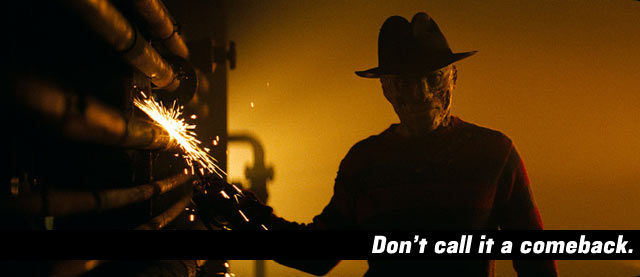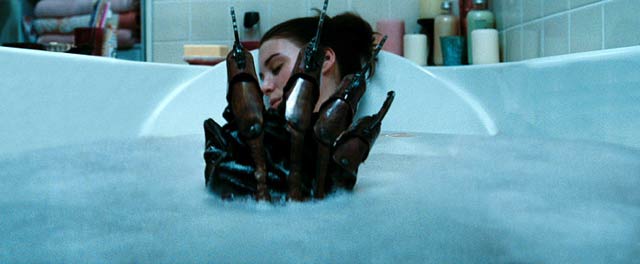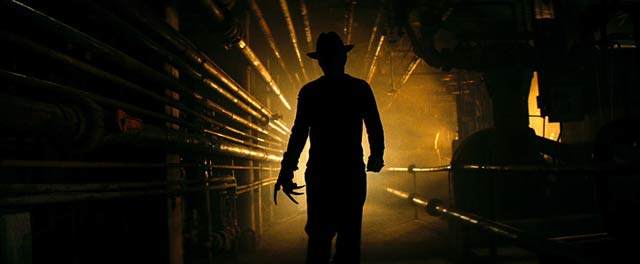Going Where Man Has Gone Before
Whence our fascination with remakes? Why do we like to go where we’ve been before? Why, particularly, do we so love horror film remakes, so much so that after decades of bad repetitions and critical and commercial failures, we still plunk down our money, expecting to be thrilled and scared by a movie we’ve already seen?
The answers are as varied as the remakes, but oftentimes we simply go where we’ve been before for the sheer joy of it. We’ve all been chased by something horrible in our dreams, and we (quite naturally) long to re-live that terror. If we’re still running from the thing, we’re still alive. And the quintessential “horrible thing” in our dreams is a man by the name of Freddy Krueger.

Remaking A Classic
How does one go about remaking something like A Nightmare on Elm Street, the film that introduced audiences to what would become one of our most popular horror icons? What does the Elm Street of 2010 have to offer that the Elm Street of 1984 didn’t — or couldn’t?
The Nightmare remake was announced in 2008, with producer Michael Bay and his Platinum Dunes production company looking to abandon the “wisecracking” Freddy Krueger that started to become popular by A Nightmare on Elm Street 3: Dream Warriors (1987) and focus on making “an actual horror film.” Co-producer Brad Fuller also made it clear that this was not a “reboot” or “re-imagining” — he had no qualms about using the term “remake” to describe the project.
Samuel Bayer, a former commercial director, was hired to direct the film in February 2009 (Bayer actually declined the offer twice before receiving a personal letter from Bay himself). Wes Craven, the director of the original film, expressed his displeasure in the film in June 2009, as he hadn’t been asked to be involved as he had with the Hills Have Eyes and Last House on the Left remakes. However, Robert Englund (the former Freddy) was excited about the project, as he felt it was time Nightmare was remade and was curious to see how CGI could “explore the dreamscape” in ways Craven couldn’t back in 1984.

Going Deeper, Going Darker
Bayer, indeed, was looking forward to going deeper into the dream world with the help of today’s film making technologies. But more than throwing up a bunch of CGI and saying, “Here’s your nightmare,” he was also looking to give audiences a much “darker” look at Elm Street… and its demon.
Wesley Strick was hired to write the screenplay, with Eric Heisserer brought in for rewrites. The script focused on Freddy Krueger, the man, and how he became a monster. The Fred Krueger of the 2010 Elm Street was a much darker creature than Craven ever envisioned — or, rather, ended up not envisioning. Craven originally pictured Freddy as a child molester but later changed him to a “child killer” so as not to discourage the audience. The 2010 remake embraced this original concept of Freddy and made him a child molester — which, on both a conscious and subconscious level, is somehow much worse than being simply a “child killer.”
Finding Freddy
The casting of Jackie Earl Haley was announced in April 2009. Haley was certainly no stranger to playing a child molester, and indeed it was his performance in Little Children that brought him to the attention of the Elm Street team. Haley’s physical size, in particular, brought something new to the role. Robert Englund approved of the casting of his successor, stating, “Jackie is not big, and I think that Jackie’s size is gonna really work. One of the metaphors I’ve used for Freddy is a little rabid dog that just bites your ankle and holds on, and I think Jackie brings that, with his own physicality, to the role, without ever having to work it a little bit.”
The producers were looking for a brand-new makeup design for Freddy Krueger as well, abandoning the now-“iconic” look of Englund’s Freddy and exploring a more realistic (but not too realistic) approach to the look of a severe burn victim. The effects team that worked on the Two-Face design in The Dark Knight designed and created the new Freddy, with subtle CGI assists applied to the prosthetic makeup to give it that little extra something, such as having a hole in his cheek. Initially, the entire makeup process took about six hours to apply to Haley, though the crew soon got it down to about three and a half. The result was a much more terrifying — and more aesthetically real — Freddy Krueger, a true monster for today’s jaded seen-it-all audiences.
A Dream Come True
New Line, of course, considered converting the film to 3-D, though Michael Bay and his producing partners fought against this, and ultimately they all agreed that a 3-D version of A Nightmare on Elm Street wouldn’t be “the best version of the film.” The film was released (in regular ol’ 2-D) on April 30, 2010 and went on to gross over $63 million in domestic box office with an additional $52 million overseas.
With a worldwide box office take of over $115 million, the Elm Street remake can be considered a success of dream-like proportions. Which means the producers now have to consider the challenge of remaking A Nightmare on Elm Street 2: Freddy’s Revenge.

Want More? Read More Get Your Gore On
Watch this scary movie and many other Halloween favorites all month long with Movies On Demand on cable. Titles and availability may vary by cable provider. Click here to locate your cable provider.

Sponsored Post
.

Comments
A Nightmare On Elm Street: The Making Of A Remake